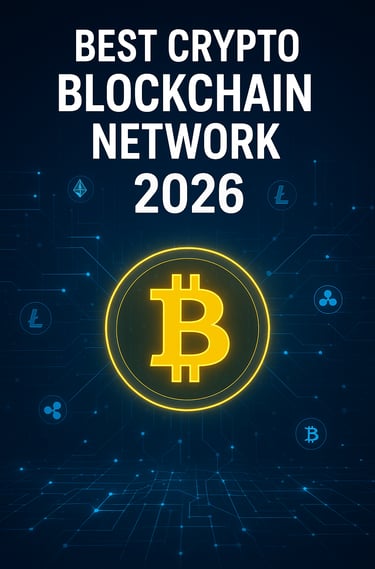Which is the Best Crypto Network in 2026? Complete Guide with DropFinder
IN THIS BLOG WE WILL DISCUSS ABOUT BEST BLOCKCHAIN
ICOLATEST AIRDROPCRYPTO NEWS
10/3/20255 min read
Which is the Best Crypto Network in 2026? Complete Guide with DropFinder
The cryptocurrency world in 2026 is far more advanced, diverse, and competitive than it was even a few years ago. With the rise of blockchain-based ecosystems, decentralized finance (DeFi), NFTs, Web3 applications, and global adoption, the question of which crypto network is truly the best has become a central debate for both investors and developers.
Each blockchain network offers unique advantages—some are faster, some are more secure, some are more decentralized, and others are better for scalability and low transaction costs. Choosing the right network depends on your goals, whether it’s trading, building dApps, investing long-term, or exploring DeFi.
In this blog, we’ll explore the top crypto networks in 2026, compare their strengths and weaknesses, and answer the big question: Which crypto network is the best today? We’ll also use insights from DropFinder, a trusted source for crypto trends and opportunities.
Why Crypto Networks Matter in 2026
Crypto networks are the backbone of the digital economy. Without them, cryptocurrencies, NFTs, and Web3 apps wouldn’t exist. They determine transaction speed, fees, scalability, and the safety of billions of dollars locked in digital assets.
In 2026, networks are competing to solve the famous blockchain trilemma:
Security – Protecting assets and data.
Decentralization – Avoiding central points of failure.
Scalability – Handling millions of users and transactions efficiently.
Different networks prioritize different aspects, which is why no single blockchain is perfect.
The Top Crypto Networks in 2026
Let’s look at the leading networks and evaluate their current status.
1. Bitcoin (BTC) Network
Bitcoin remains the king of cryptocurrencies in 2026, with unmatched brand recognition and global adoption. While it is not the fastest or most scalable, Bitcoin’s security and decentralization are its strongest assets.
Strengths:
Most secure blockchain in the world.
Widely accepted as a store of value (“digital gold”).
Increasing institutional adoption.
Layer 2 solutions like the Lightning Network make payments faster and cheaper.
Weaknesses:
Limited scalability compared to modern networks.
Not ideal for DeFi or dApps.
High energy consumption (though improving with greener mining).
Bitcoin is still the safest bet for long-term value storage but not the best for building applications.
2. Ethereum (ETH) Network
Ethereum continues to dominate the smart contract and DeFi ecosystem. With its upgrade to Ethereum 2.0 completed by 2025, the network now runs on Proof of Stake (PoS), making it greener and more scalable.
Strengths:
Largest ecosystem of dApps, DeFi, and NFTs.
Widely adopted by developers.
Layer 2 rollups (Arbitrum, Optimism, zkSync) provide low-cost transactions.
Constant innovation with AI and Web3 integration.
Weaknesses:
Still faces congestion during peak usage.
Gas fees can rise, though much lower than in early years.
Competition from newer chains with higher speeds.
Ethereum remains the best all-rounder network for developers, DeFi, and innovation.
3. Binance Smart Chain (BNB Chain)
The BNB Chain, powered by Binance, is a top competitor due to its low fees and high transaction speed. It has become a go-to network for retail investors and smaller DeFi projects.
Strengths:
Very low transaction fees.
Fast transactions.
Large user base thanks to Binance’s exchange integration.
Easy for developers to deploy dApps.
Weaknesses:
Less decentralized (heavily controlled by Binance).
Security concerns from frequent hacks of BNB-based projects.
Considered less “trustworthy” by purists.
BNB Chain is excellent for cheap, fast, and easy access to DeFi but lacks Ethereum’s decentralization.
4. Solana (SOL) Network
Solana is known as the speed king of blockchains, capable of handling thousands of transactions per second with low fees. Despite facing outages in earlier years, Solana has matured significantly by 2026.
Strengths:
Ultra-fast transactions.
Very low fees.
Popular for NFTs and Web3 gaming.
Large developer community.
Weaknesses:
Past network outages hurt its reputation.
Still not as decentralized as Ethereum or Bitcoin.
Competing with many other “fast chains.”
Solana is the best choice for high-performance applications, especially in gaming, NFTs, and DeFi that require speed.
5. Cardano (ADA) Network
Cardano is often called the “academic blockchain” due to its scientific approach. By 2026, it has finally delivered on many of its promises with advanced smart contracts and strong sustainability.
Strengths:
Environmentally friendly Proof of Stake.
Strong focus on peer-reviewed research.
Growing adoption in Africa and developing nations.
Very secure and scalable.
Weaknesses:
Slow development compared to competitors.
Smaller ecosystem than Ethereum or BNB.
Still struggles with mainstream developer adoption.
Cardano appeals to those looking for a sustainable and secure blockchain for the long term.
6. Avalanche (AVAX)
Avalanche is a network that focuses on speed, interoperability, and scalability. It is highly popular for enterprise adoption and DeFi.
Strengths:
Very fast finality (transactions confirmed in seconds).
Interoperable with other blockchains.
Popular for institutional-grade projects.
Supports subnetworks (custom blockchains).
Weaknesses:
Smaller user base compared to Ethereum or Solana.
Limited mainstream adoption.
Avalanche shines in enterprise blockchain solutions and DeFi projects that need scalability.
7. Polkadot (DOT)
Polkadot is all about cross-chain compatibility. Its parachain structure allows different blockchains to interact seamlessly.
Strengths:
Enables multiple blockchains to work together.
Highly scalable.
Strong developer interest.
Decentralized governance model.
Weaknesses:
Adoption still limited compared to Ethereum or Solana.
Complex for new users.
Polkadot is best for cross-chain innovation and interoperability.
8. Cosmos (ATOM)
Cosmos brands itself as the “Internet of Blockchains,” focusing on creating a network of interconnected blockchains.
Strengths:
Excellent interoperability.
Strong security.
Growing adoption for cross-chain DeFi.
Active developer community.
Weaknesses:
Smaller ecosystem compared to Ethereum or Solana.
Still faces competition from Polkadot.
Cosmos is strong for interconnected blockchain projects and DeFi innovation.
9. Ripple (XRP Ledger)
Ripple focuses on global payments and remittances. By 2026, despite regulatory battles, Ripple has positioned itself as a leading network for cross-border financial transfers.
Strengths:
Lightning-fast international payments.
Low fees.
Partnerships with banks and financial institutions.
High scalability.
Weaknesses:
Centralization concerns.
Regulatory challenges continue in some regions.
Ripple is the best for cross-border financial transactions but not as strong for DeFi or NFTs.
10. New Emerging Networks in 2026
Apart from the established giants, newer networks are entering the scene with unique features:
Aptos & Sui: Known for scalability and Web3 adoption.
Layer 2 Networks (Arbitrum, zkSync): Scaling Ethereum to new heights.
AI-Integrated Chains: New blockchains designed for artificial intelligence applications.
According to DropFinder, many new investors are exploring upcoming chains for early adoption opportunities, similar to how early adopters of Solana and Avalanche profited years ago.
CEX, DEX, and Network Choice
Your choice of network also depends on how you trade:
On CEX platforms, Bitcoin, Ethereum, and BNB dominate.
On DEX platforms, Solana, Avalanche, and emerging Layer 2 chains are gaining traction.
According to DropFinder, most users prefer a multi-chain strategy, investing in both established and upcoming networks.
Which is the Best Crypto Network in 2026?
Now comes the ultimate question: which network is the best in 2026?
The answer depends on your priorities:
For security & store of value → Bitcoin
For DeFi & dApps → Ethereum
For low fees & accessibility → BNB Chain
For speed & NFTs/gaming → Solana
For sustainability & research-driven growth → Cardano
For interoperability → Polkadot or Cosmos
For institutional use cases → Avalanche
For payments & remittances → Ripple
No single blockchain is perfect. Instead, the future is multi-chain, where different networks coexist and serve different needs.
DropFinder Insights
According to DropFinder’s 2026 crypto reports, the trend shows:
Ethereum is still the most dominant for builders.
Solana is gaining ground in gaming and NFTs.
Bitcoin remains the safest long-term investment.
Emerging chains offer high-risk, high-reward opportunities.
Multi-chain adoption is the clear path forward.
Investors who diversify across multiple networks are more likely to benefit than those betting on just one.
Conclusion
So, which is the best crypto network in 2026? The truth is, there is no single winner. Each blockchain serves different purposes: Bitcoin is digital gold, Ethereum powers DeFi, Solana drives NFT ecosystems, and BNB provides fast, cheap access.
The real best strategy is a multi-chain approach—adopting the strengths of each network while minimizing risks. With platforms like DropFinder guiding users toward the most promising projects and airdrops, investors can make smarter decisions in this rapidly changing space.
In the end, the best crypto network in 2026 is not about one blockchain but about how you use them together to shape your future in the digital economy.




